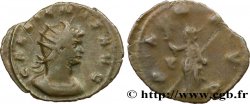brm_676532 - GALLIENUS Antoninien
75.00 €(Approx. 77.25$ | 62.25£)
Quantity
Add to your cart

Type : Antoninien
Date: 259
Mint name / Town : Atelier secondaire d’Asie
Metal : billon
Diameter : 20 mm
Orientation dies : 6 h.
Weight : 4,1 g.
Rarity : R1
Coments on the condition:
Monnaie bien centrée frappée sur un flan ovale, avec un joli buste de l’empereur et un joli revers détaillé. Possède une partie de son argenture, patine grise
Obverse
Obverse legend : IMP C P LIC GALLIENVS P F AVG.
Obverse description : Buste radié, drapé et cuirassé de Gallien à droite vu de trois quarts en arrière (A2).
Obverse translation : “Imperator Cæsar Publius Licinius Gallienus Pius Felix Augustus”, (L’empereur césar Publius Licinius Gallien pieux heureux auguste).
Reverse
Reverse legend : IOVI CONSERVATORI.
Reverse description : Gallien et Jupiter debout face à face. Gallien est debout à gauche, tenant le scipio de la main droite. Jupiter est debout à droite, nu, le manteau sur l'épaule, tenant un globe de la main droite et un sceptre de la gauche ; au milieu, au-dessus, une couronne.
Reverse translation : “Iovi Conservatori”, (À Jupiter protecteur).
Commentary
Poids lourd.








 Report a mistake
Report a mistake Print the page
Print the page Share my selection
Share my selection Ask a question
Ask a question Consign / sell
Consign / sell
 Full data
Full data









